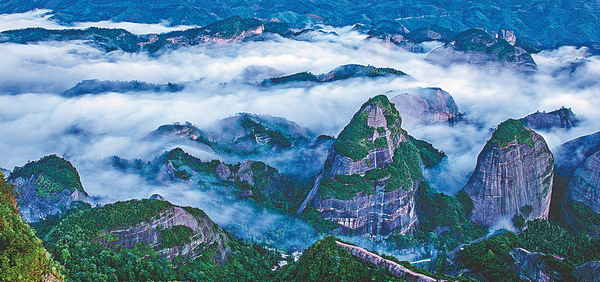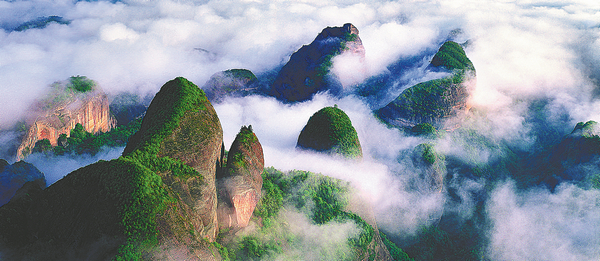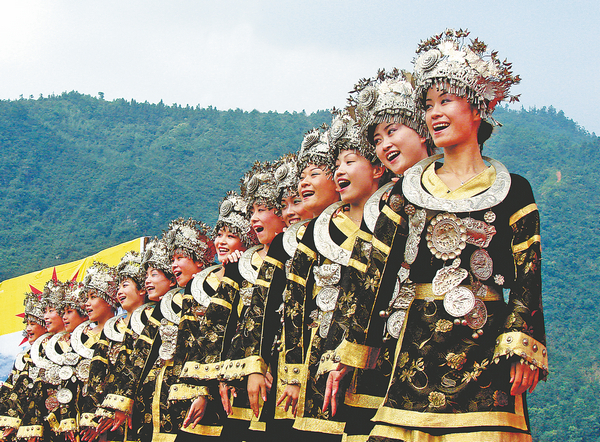
Villages are often named after the mountains they are perched upon, but Bajiaozhai, or a village having eight horns, in Ziyuan county of Guangxi Zhuang autonomous region and neighboring Xinning county of Hunan province, is a pseudo-karst mountain range with eight peaks featuring Danxia landform, or steep red cliffs.
The karst topography is common in areas underlain by limestone, but in Danxia it is formed from red-colored sandstone and its conglomerates. And they were both formed by endogenous forces, including uplift, and exogenous forces, including weathering and erosion.
Although two out of the eight peaks are located in Ziyuan and the other six in Xinning, more than half of the Bajiaozhai zone (or 125 square kilometers), which is also called Yuntai Mountain, stretches into Ziyuan on the Guangxi side, and less than half of it (108 sq km) into Xinning.
As another tourist spot in Jiaozuo, Central China's Henan province, bears the same name of Yuntai Mountain, the eight-peak mountain stretching across Guangxi and Hunan is better known as Bajiaozhai in the country.

It is good to see the two counties cooperating well with each other to manage the sizable scenic zone stretching across two provincial-level regions.
The highest of the eight peaks stands 818 meters above sea level, and the lowest 450 meters. There are about 130 scenic spots in the zone-many of which are microscopic landforms formed by water erosion-and sightseers can see them on the two sides of the delicately-designed travel routes meandering through the peaks. It takes about three hours to finish the tour on foot.
And they can also take the cableway, which provides a breathtaking view, especially when there is a sea of clouds on the mountains, making the peaks look like islands dotted in endlessly flowing clouds. Only when one sees all peaks together can one understand or marvel at the uniqueness of the place.
From the foot of the mountain, only on the Ziyuan side, people can see eight peaks, like they were eight dragon heads. So more tourists come to the mountains from the Ziyuan side, which is close to Guilin, an international tourist attraction known for its Lijiang River and karst mountains.

Atop the mountain lie the ruins of the Yuntai Temple built during the Ming Dynasty (1368-1644), and those of the Tiankong Temple built in the Song Dynasty (960-1279).
The peaks are of various forms and slight changes in light during different weather conditions, such as fog, bring the peaks alive, a visual treat for sightseers, photographers and painters alike.
Some geologists and world natural heritage evaluation experts, who have seen so many picturesque landscapes elsewhere, had a different experience altogether while doing field work in Bajiaozhai.
Traditional activities are organized regularly during festivals here, as both Guangxi and Hunan are home to multi-ethnic minority groups.
In Bajiaozhai, surface water has eroded red conglomerates formed 67 million years ago, during the Cretaceous period, along vertical joints, forming a rare Danxia landform landscape in the country.
With an annual temperature of 19 C, the scenic area has good vegetation and forest landscape, in which live a large number of precious plants and rare birds and animals.
In 2005, the Chinese National Geography selected Bajiaozhai as one of the most beautiful Danxia landforms in China-the others are in Guangdong, Fujian, Jiangxi, Guizhou and Gansu.
The local government attracted investors who spent 700 million yuan ($104.59 million) from 2016 to 2018, upgrading the region's infrastructure to a 4A-level national sightseeing zone (5A being the top level).
In brief, Bajiaozhai has a good combination of geology, topography, botany and anthropology, and its fresh air and pleasant temperature and humidity make it a tourist attraction throughout a year.